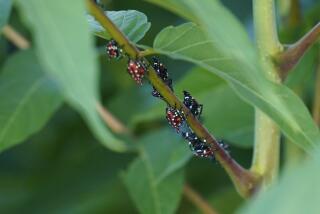Tiny Bugs Assaulting Stands of Hemlocks in Catoctin Mountain Park : Environment: The endangered zone for the trees stretches from the Carolinas to southern New England. The insects also are spreading to western Pennsylvania.
- Share via
THURMONT, Md. — Fly fishers take note: Tiny bugs are attacking stands of hemlocks that shade a well-known fishing stream near Camp David and help keep its waters chilly enough for trout to thrive.
Woolly adelgids are sucking the sap out of hemlocks throughout the Northeast and mid-Atlantic states. In Maryland’s Catoctin Mountain Park, home to the presidential retreat, they are assaulting trees along a five-mile stretch of Hunting Creek.
Presidents have fished this stream, and it’s a favorite among anglers from Washington and Baltimore. Native brook trout and stocks of brown and rainbow trout swim its cool waters.
“Right now it appears that all of the groves of hemlocks throughout the park are affected,” said park ranger Becky Reddinger. “We don’t know if we have had any mortality, but it’s only a matter of time.”
Without shade from trees, streams can get too warm for the fish, she said. Additionally, if the hemlocks were to die and disappear, stream banks could eventually erode, silting up the clear waters.
At first glance, the towering hemlocks seem healthy, their large boughs sweeping toward the sky. But the undersides of the branches appear to have been sprayed with aerosol snow: clumped at the base of all the green needles are white egg masses.
Each ball contains 15 to 20 woolly adelgids, insects that originated in Asia, most likely Japan. The white sacs are present year-round but are especially prominent in the spring when the insects cause the most damage.
“They suck the sap out of the base of the needles,” Reddinger said. Scientists “also think they might be injecting some sort of toxic spittle into the tree, but they’re not sure about that. The needles then discolor and fall off.”
The loss of needles and new shoots seriously damages the trees, which can die within several years. And rangers can do little to fight the pest.
Oily insecticides can suffocate the adelgids, but they are difficult to apply because the insects live on the undersides of the branches. Aerial spraying would not only be ineffective but could also harm aquatic and plant life in Hunting Creek, Reddinger said.
Mark McClure, chief scientist at the Connecticut Agricultural Experiment Station, is working on the most promising natural enemy--a mite that feeds on the waxy wool of the egg sacs. He is expecting a spring shipment from Japan of the mites and other natural predators of the woolly adelgid.
Woolly adelgids don’t threaten hemlocks in Japan because natural enemies keep their populations in check, McClure said. Also safe are the Pacific Northwest’s hemlocks, which are resistant to the insects.
The endangered zone for East Coast hemlocks stretches from the Carolinas to southern New England. Woolly adelgids are spreading into western Pennsylvania at a good clip, McClure said, and dead hemlocks have been reported in Virginia, Pennsylvania and New Jersey over the last five years.
“We can save the ornamental hemlocks by spraying, but in terms of the forests, they are being severely threatened by this insect,” McClure said.
That is certainly the case in Virginia’s Shenandoah National Forest. Hemlocks grow in 94 areas covering 2,000 acres of the 195,000-acre forest, said entomologist Keith Watson.
“Only 25% of all the hemlocks in the park are considered healthy,” Watson said. “We don’t have that many dead trees, but they’re just hanging there on the edge.”
More to Read
Sign up for Essential California
The most important California stories and recommendations in your inbox every morning.
You may occasionally receive promotional content from the Los Angeles Times.











